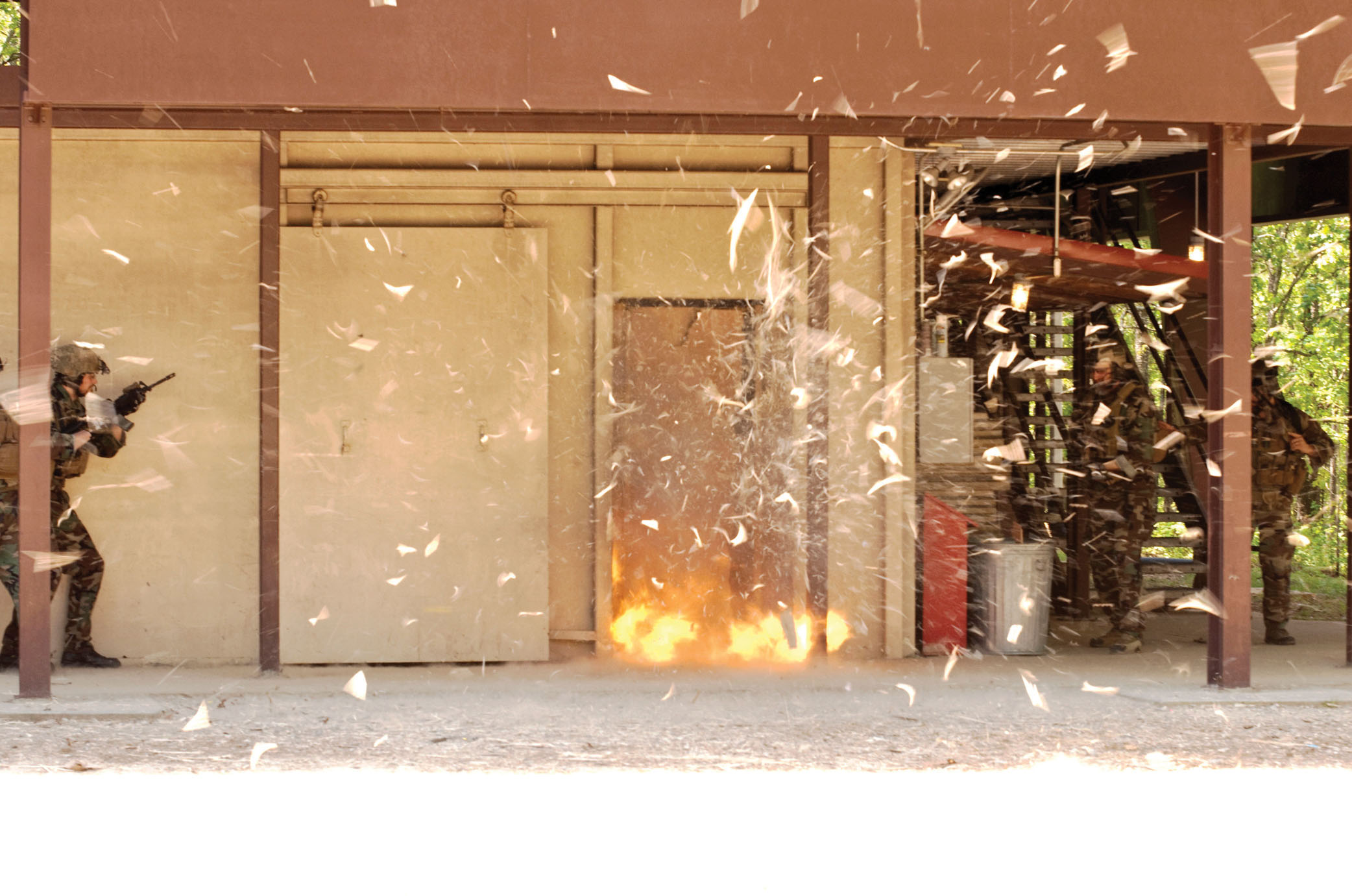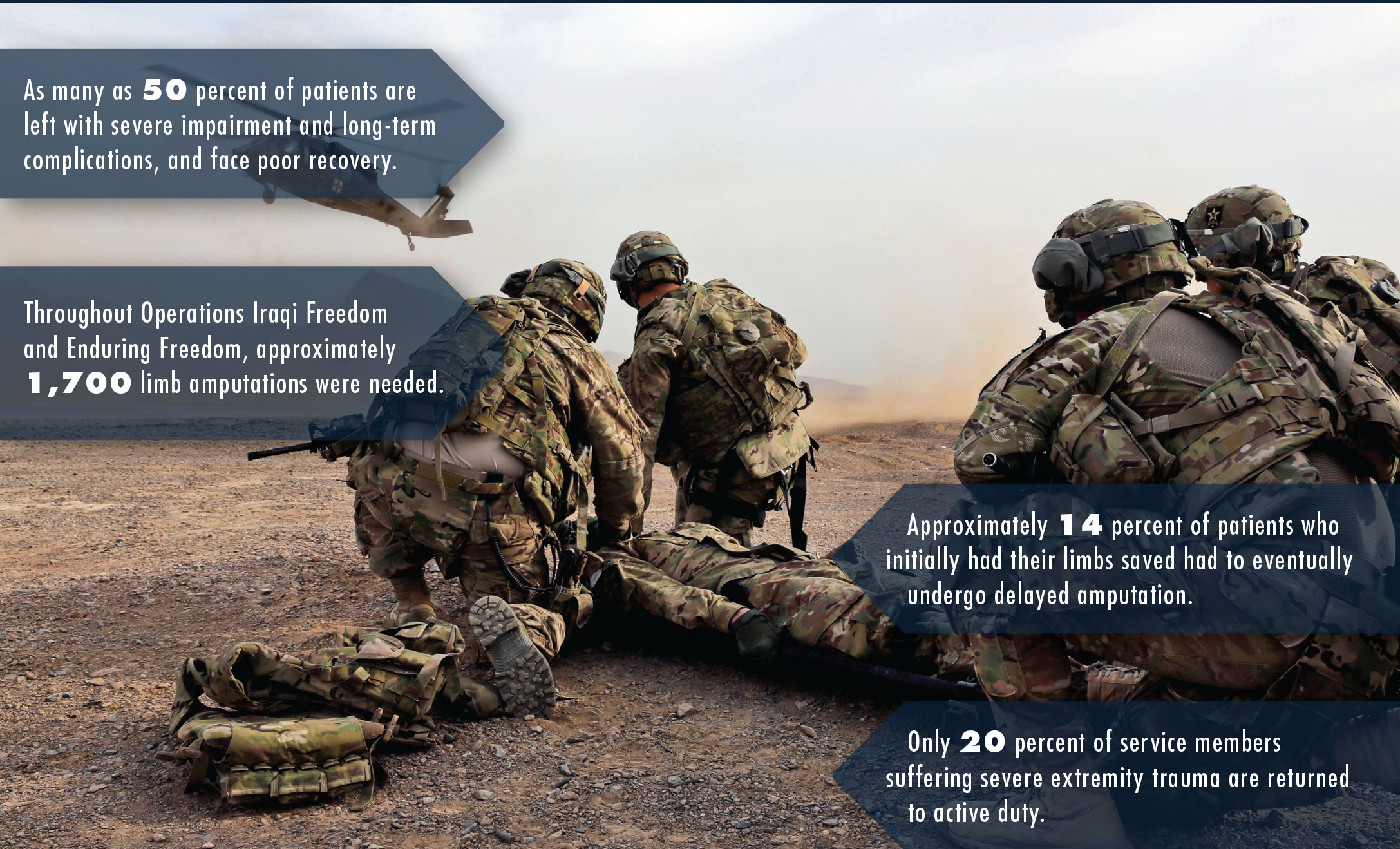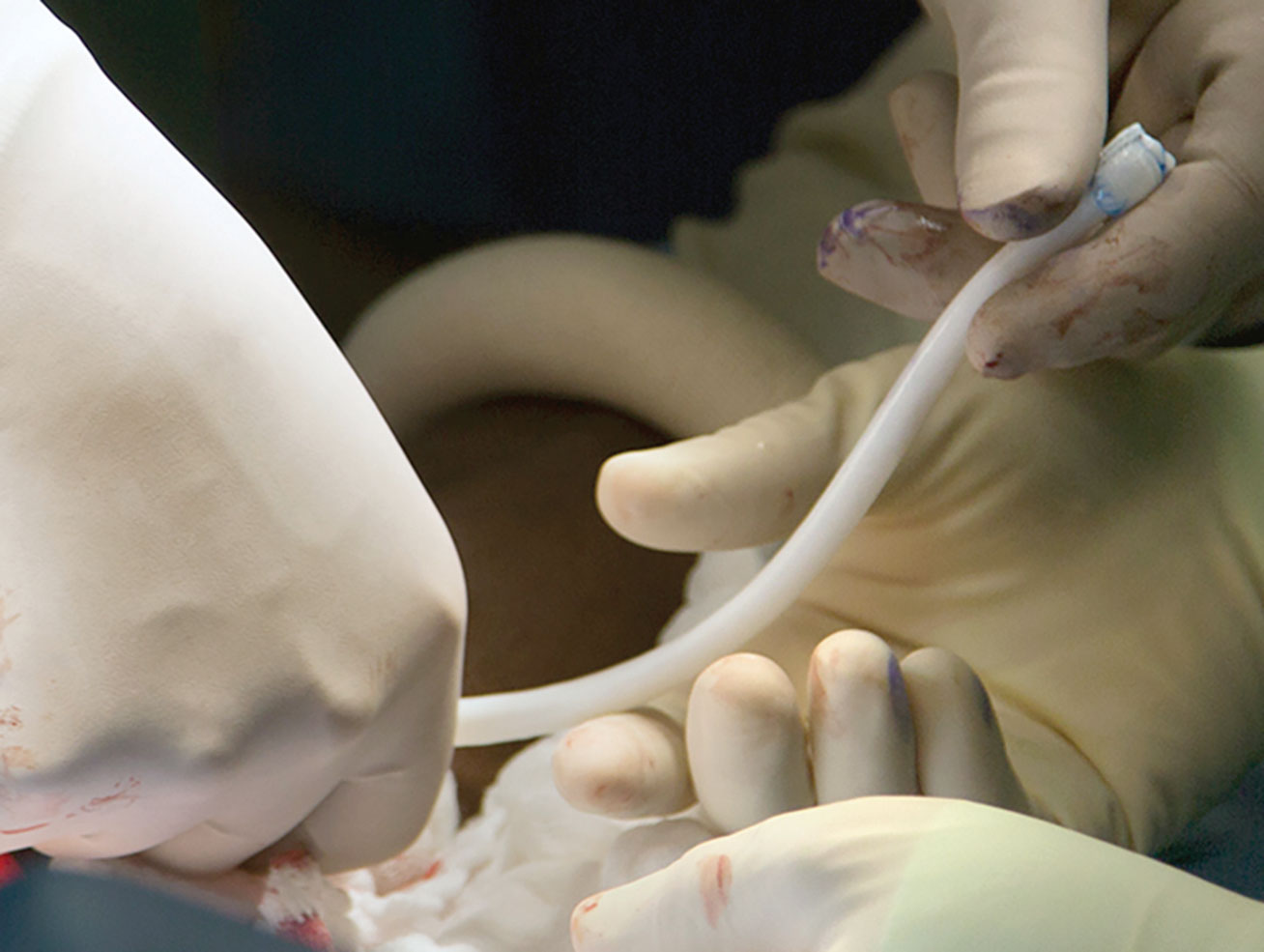
Wounds that used to kill don’t, but IED attacks leave many service members with severe, lasting damage to legs or arms. So the Tissue Injury and Regenerative Medicine office stamps a high priority on extremity repair.
by Ms. Kristy Pottol, Lt. Col. Melinda Eaton and Lt. Col.(P) David Saunders
Compared with the Vietnam War, body armor and improved battlefield resuscitation have increased survivability in recent conflicts in Iraq and Afghanistan; however, the downstream effect is a greater number of extremity wounds leading to higher levels of disability.
Improvised explosive devices (IEDs) often cause serious damage to the limbs. As many as 50 percent of service members with extremity injuries suffer from severe impairment and long-term complications. Although many injured personnel want very much to return to their units and continue their assignments, the prognosis is poor for regaining all the function they had in the limb before the injury.
To improve the prognosis for extremity wounds, the Tissue Injury and Regenerative Medicine Project Management Office (TIRM PMO) of the U.S. Army Medical Materiel Development Activity (USAMMDA) has placed a high priority on extremity repair, with an emphasis on regenerative medicine. Based on the state of the science, four promising focus areas exist for extremity repair: permanent vascular repair, peripheral nerve repair, muscle repair, and bone and connective tissue repair.

SEIZE THE ‘GOLDEN HOUR’
New techniques in extremity repair are centered on restoring blood flow to trauma wounds as close as possible to the point of injury. DOD investment in trauma-specific injuries and medical procedures is important because trauma sends far fewer civilians to the hospital than other injuries, so the medical industry conducts less research in this area. (U.S. Army photo by Sgt. Michael J. MacLeod)
VEIN REPAIR
The current standard of care for permanent vascular repair involves three types of procedures: autografts, synthetic grafts and endovascular grafts. The most common of the three, autografts, require that a donor blood vessel be taken from the patient, often from the leg. While this is the most permanent solution for vascular repair, damage to lower limbs may limit this approach. Currently available synthetic grafts made of Dacron or Teflon are sometimes used, but the high risk of infection makes these a distant second choice.
Endovascular grafts, inserted through a special catheter, are being used increasingly for smaller injuries since they avoid the need for open surgery. However, these require highly specialized equipment and training, limiting their use to stateside facilities. Advances in regenerative medicine have created grafts that model themselves after the patient’s own vessels, resist infection and mature into vessels that look much like the patient’s own.
Vascular repair is an area with numerous commercial civilian applications, including heart and leg bypass grafting, dialysis for patients with kidney disease and others. Because of the large potential commercial market, DOD investment is focused on studying these novel grafts in trauma patients in accordance with the U.S. Food and Drug Administration. A bioengineered blood vessel in phase three of clinical trials may prove useful for repair of injured arteries and veins.
SPEEDING NERVE REGROWTH
Although peripheral nerves—those that control sensation and movement—can regenerate in the body after injury, they do so very slowly. Furthermore, after initial injury the nerves lose function, often for several months. As a result, although the nerves regrow, the muscles powered by these nerves deteriorate and lose function temporarily. Using current technology, surgeons cannot predict which nerves will regrow successfully; therefore, the injury often leaves patients with poor functional outcomes. Options for treatment are limited; the current standard of care involves transferring the patient’s own nerves from other areas of the body, such as the leg, to restore function in the hand.
Areas of intended DOD investment in this area focus on products that can speed nerve regrowth. In addition, DOD is evaluating products that can preserve muscle and nerve function and prevent further degeneration during injury healing. Examples of products being developed by academia and industry include nerve growth factors, bioengineered scaffolds and tools to prevent degeneration.

MEDICINE, RIGHT OF BOOM
Body armor and better battlefield resuscitation are keeping more service members alive after explosions. A second-order effect of this is the large number of extremity wounds Army medical personnel now see. As a result, the TIRM PMO is focusing on harnessing the ability of human cells to regenerate—to regrow—and offering that solution to injured service members. (Photo courtesy of Sharilyn Wells, Paraglide)
KEY TARGET: MUSCLE REPAIR
Major muscle tissue loss following combat-related trauma is complicated by infection or damage to the surrounding bone, nerves or blood vessels. Unfortunately, little can be done to combat volumetric muscle loss as muscle regenerates poorly and there are limited options for surgical repair.
Current treatment of volumetric muscle loss is geared toward rehabilitation to preserve the patient’s remaining muscle function. In certain cases, surgeons can use muscle from elsewhere in the body (known as a muscle flap transfer) to repair more critical areas such as the hand or face.
However, these procedures are plagued by complications and poor outcomes, with little academic or industrial research being conducted because of a very small potential commercial market. As a result, DOD-targeted investments in volumetric muscle loss treatment are likely to have the greatest overall impact as compared to the other areas.
BONE AND CONNECTIVE TISSUE REPAIR
While bone normally repairs spontaneously after a fracture, munition blasts can create complex fragmented injuries that do not heal, as it is much like trying to reassemble shattered glass. In such cases, our immediate focus is on products that stabilize complex bone injuries using materials that are integrated into the body, prevent infection and promote healing.
Long-range targets will support prevention and treatment of post-traumatic osteoarthritis, which causes damage to joints following severe injuries, similar to deterioration experienced in old age.

THE CURRENT PROGNOSIS
By almost any measure, service members whose arms or legs are injured in combat face a grim outlook. Few recover the full use of the injured extremity. USAMMDA breaks the task of improving this prognosis into four focus areas: repairing blood vessels, repairing nerves, preventing muscle loss and stabilizing complex bone fractures. (SOURCE: USAMMDA)
FROM BENCH TO BATTLEFIELD
The TIRM PMO works with a broad network of collaborators in industry, academia and government to accelerate the development of new medical products, specifically regenerative medicine technologies. The overriding goal is to rapidly acquire emerging technologies to make wounded service members whole again by restoring form, function and appearance. Because trauma is relatively rare compared with chronic diseases such as cancer and diabetes, the challenge for DOD has been selecting commercially viable candidates to meet a military need among a rapidly growing field of cutting-edge technologies.
DOD has invested in regenerative medicine through different mechanisms because of new scientific breakthroughs in the field, which emerged in the early 1990s and allow scientists to better harness the body’s own healing powers through the use of stem cells and tissue engineering. Regenerative medicine is about growing specific cell types and directing these cells toward a final outcome such as new skin, blood vessels or muscle.
This technology advancement led to the 2008 launch of the Armed Forces Institute of Regenerative Medicine by the U.S. Army Medical Research and Materiel Command, USAMMDA’s higher headquarters. The institute has translated scientific research into clinical outcomes, which indicates to the TIRM PMO that the technology is ready for robust product development. A number of projects are moving through the acquisition process, notably the permanent vascular graft and skin substitutes.
LIMB LOSS TOLL STILL HIGH
Current options for patients who lose a limb can range from simple prosthetics to more advanced robotic limbs to entire hand transplants. At the simplest level, rudimentary prosthetics provide basic functions such as grasping and walking. More advanced robotic prostheses provide greater functionality, including the ability to manipulate larger objects, run and perform more subtle movements, particularly of the arm and hand. These advanced systems have become highly sophisticated, allowing direct patient control, in some cases through “rewired” amputation stumps.
Another newly available option includes transplant of hands from deceased donors. This emerging surgical technique offers the possibility of far greater control and sensation from a living hand. However, as with other types of organ transplants, the patient must take lifelong medicines to prevent rejection of the donated hand. Both hand transplant and robotic arm prosthetics remain limited in availability to a few national academic centers. The associated high costs and experimental nature also present challenges in health insurance coverage, which remains a necessity for lifetime support of the patient.
None of these emerging technologies can wipe away the emotional and mental toll of traumatic injury. Even the successful adoption of a prosthetic or transplanted limb requires tremendous patience and perseverance for the patient’s journey to a new “normal” life. Current medical solutions simply may not make wounded warriors whole again.

BIOENGINEERED VESSEL
The TIRM PMO is working with industry partners to realize an organic, “human” product that will afford a more permanent solution to repair damaged vessels after traumatic injury on the battlefield. The best option available for many service members right now is for doctors to take a blood vessel from the leg and transfer it to the injured limb. (Photo courtesy of Duke University)
CONCLUSION
USAMMDA maintains a team of specialized acquisition professionals committed to translating cutting-edge research into fielded products to maintain a medically ready force. As part of the current military acquisition program, the TIRM PMO expands collaboration across the civilian sector to bring leading-edge regenerative medical solutions to warfighters who may return home from battle with lasting physical and mental complications.
Thousands of service members have fought across the globe to protect American freedom, and many have given their lives to defend the American way of life. Unfortunately, some returning warfighters must bear physical and mental scars from the sacrifices of armed conflict. Although military medicine now saves more lives than ever before, for some service members this progress comes at a cost: the vast number of devastating injuries leading to lifelong disability.
TIRM PMO team members realize the urgency to accelerate development as much as possible. Looking ahead to the future fight and support for a medically ready force, we must discover effective regenerative medicine solutions to restore form and function. We remain confident that our collaborations with a diverse array of industry, academic and government partners will make possible that which previously seemed impossible.
For more information, contact Kristy Pottol at Kristy.s.pottol.civ@mail.mil.
MS. KRISTY POTTOL is project manager of TIRM PMO, Fort Detrick, Maryland. She also serves as program manager for DOD’s BioFabUSA Institute effort. She holds an MBA from Regis University, an M.S. in accounting with an emphasis on information systems from the University of North Carolina Wilmington and a B.S. in physics with an emphasis in biophysics from East Carolina University. She is Level III certified in program management and is a member of the Army Acquisition Corps.
LT. COL. MELINDA EATON, USAF, is deputy project manager for TIRM PMO, responsible for oversight of diverse project areas such as burn treatment and skin repair, extremity repair and noise-induced hearing loss. She holds a D.V.M. from Washington State University, a Ph.D. in epidemiology from the University of North Carolina at Chapel Hill, a Master of Public Health from the Uniformed Services University of the Health Sciences and a Master of Library Science from Florida State University. She is Level I certified in program management and is a Project Management Professional. She holds specialty board certifications from the American College of Veterinary Preventive Medicine and the National Board of Public Health Examiners.
LT. COL.(P) DAVID SAUNDERS is product manager for extremity repair within the TIRM PMO. He is an internal medicine physician and clinical pharmacologist with extensive experience in clinical trials. He holds an M.D. from Johns Hopkins University and a Master of Public Health from Tulane University. Before his current assignment, he spent 10 years conducting antimalarial drug research with the Army in the U.S. and Southeast Asia.
This article will be published in the January – March 2018 issue of Army AL&T magazine.
Subscribe to Army AL&T News, the premier online news source for the Acquisition, Logistics, and Technology (AL&T) Workforce.







